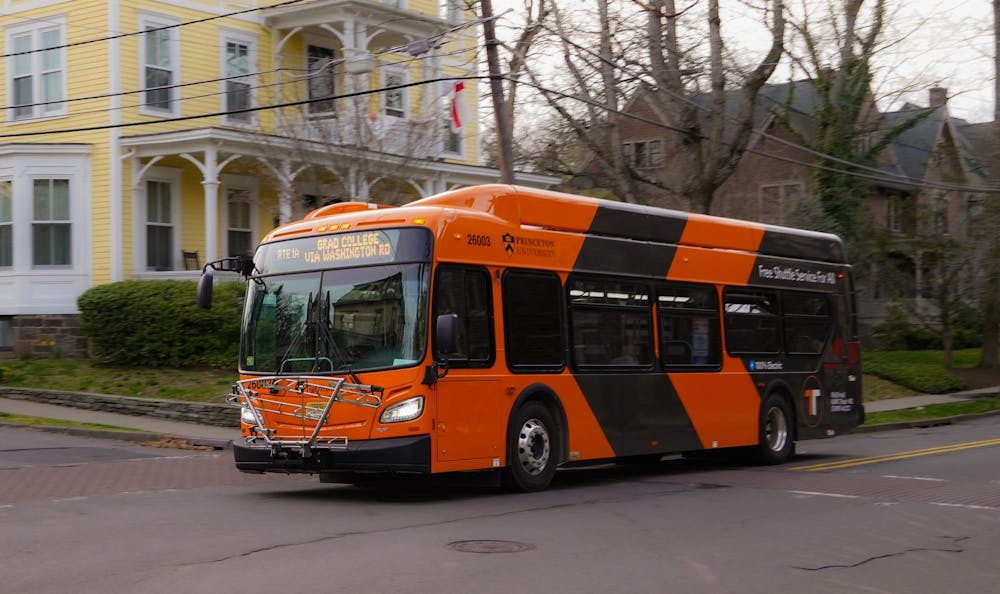Princeton has historically been a walking campus — students can make the longest trek on campus, from Forbes College to the E-Quad, in about 25 minutes.
Transportation transformation, however, may be on Princeton’s horizon.
Simultaneously, students have become more spread out on campus, with more students living in the far south of campus due to the opening of two new residential colleges in 2022, Yeh and New College West. In August, the University announced a ban on personal electric vehicles (PEVs), prohibiting electric scooters, bikes, hoverboards, and skateboards from being used within a designated zone during “peak hours” of 7:30 a.m. through 4 p.m. on weekdays.
As students grapple with transportation options, transit patterns have been changing for some time. Ridership on TigerTransit, the University’s free bus service, has increased by 60 percent from pre-pandemic levels and by over 50 percent from 2022, according to Director of Transportation and Parking Services Charles Tennyson. The growing interest in the transit service comes as TigerTransit brings 17 new battery electric buses to replace its former diesel fleet.
“We suspect that a combination of increased frequency, greater visibility and access, and reliability of bus service is likely driving the ridership increases,” Tennyson wrote in a statement to The Daily Princetonian. For example, the Goheen Walk Northbound stop on Washington Road, which is served by four TigerTransit routes, has jumped from being the 12th most used weekday stop to the fifth busiest. From here, riders can hop on any northbound bus to avoid walking up a steep path.
Tennyson also added that undergraduate transit use from residents at Butler, Yeh, and New College West could be contributing to the increase of rides.
TigerTransit runs six lines around campus and nearby towns. Two routes serve the graduate student residents of the Lakeside Apartments and the Graduate College, respectively, while the Weekend Shopper provides access to groceries and retail shopping on Route 1. Another route runs to Princeton Medical Center, the Forrestal Campus, and the Princeton Plasma Physics Laboratory (PPPL).
However, TigerTransit has also been criticized for its limited utility, as its route network operates around the periphery of campus and mostly transports graduate students, faculty, and staff from parking facilities to campus. In September, Tennyson told the ‘Prince,’ “There are no plans for TigerTransit to operate on Elm Drive in the near future.”
TigerTransit previously operated using a fleet of 14 full-size diesel buses and five smaller buses. By implementing the electric buses, 500 metric tons of tailpipe emissions will be removed from the atmosphere annually.
“Our air is cleaner because of this project,” said University President Christopher Eisgruber ’83 in an event inaugurating the new buses. However, 500 metric tons represent less than one percent of the carbon emitted by campus operations annually, according to Tennyson.
The all-electric fleet is also relatively unique for a public transit system. According to a University press release, Princeton is the first Ivy League school with exclusively emissions-free vehicles. In the same press release, Tennyson said that the University’s charging station was “one of the largest electric transit vehicle charging facilities in the country.”
According to Tennyson, there are plans to change TigerTransit routes and service patterns to accommodate the new Meadows Neighborhood development across Lake Carnegie in West Windsor Township, which is planned for completion in Spring 2024. These service changes will be announced in early January.

Recent and future changes to the TigerTransit system are part of a broader landscape of environmental efforts on campus — as geothermal energy construction projects are ongoing and the University works towards a goal of carbon neutrality by 2046 — as well as significant campus expansion. Against the backdrop of a rapidly changing campus, students can expect that transportation patterns may also experience shifts away from walking and scootering and towards alternative modes of movement.
TigerTransit users can share feedback on the service with the University through its “Tell us how TigerTransit is doing” feedback form.
Ryan Konarska is an associate Data editor and staff News writer for the ‘Prince.’
Louisa Gheorghita is a staff News writer and photographer for the ‘Prince.’
Please send any corrections to corrections[at]dailyprincetonian.com.








